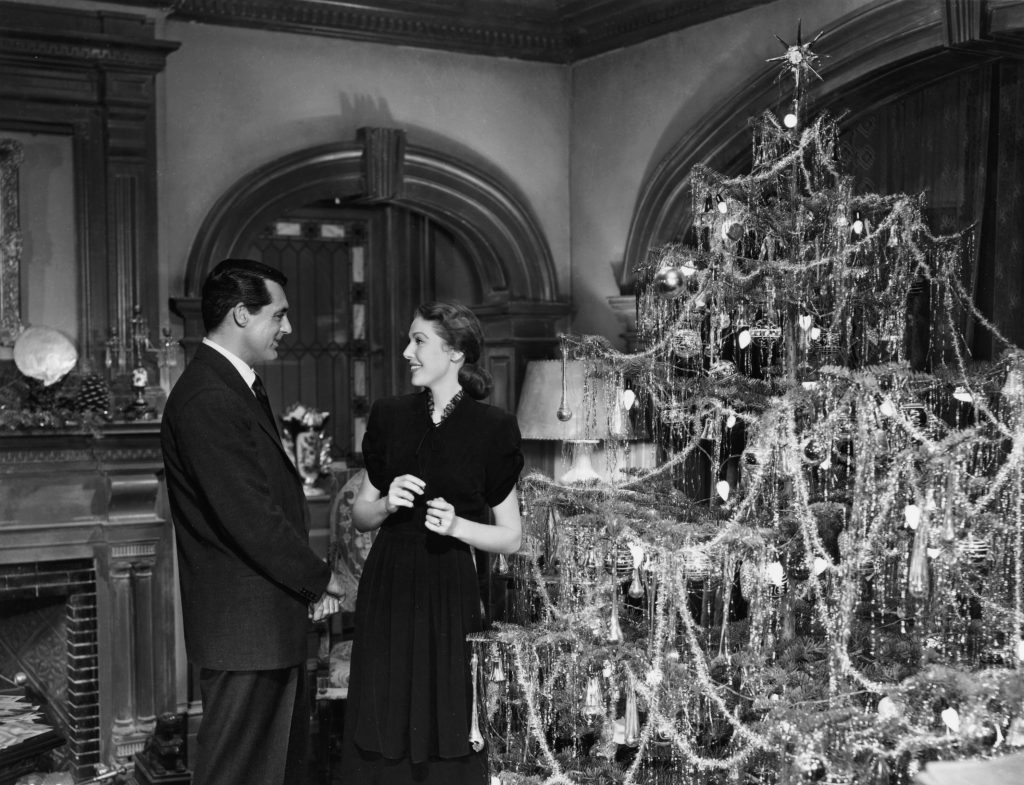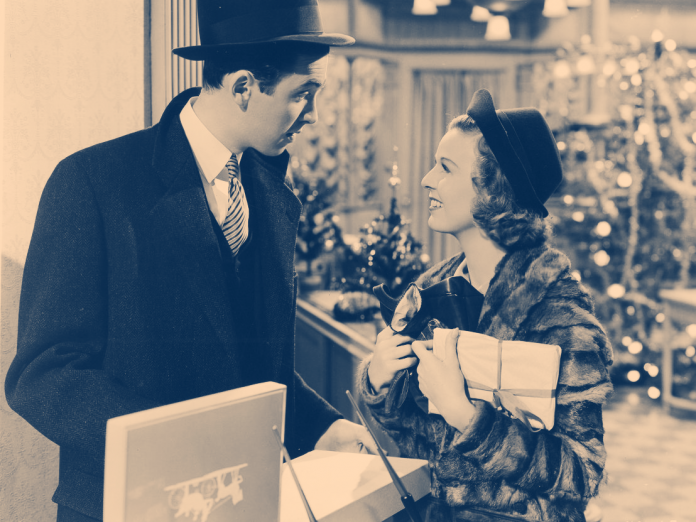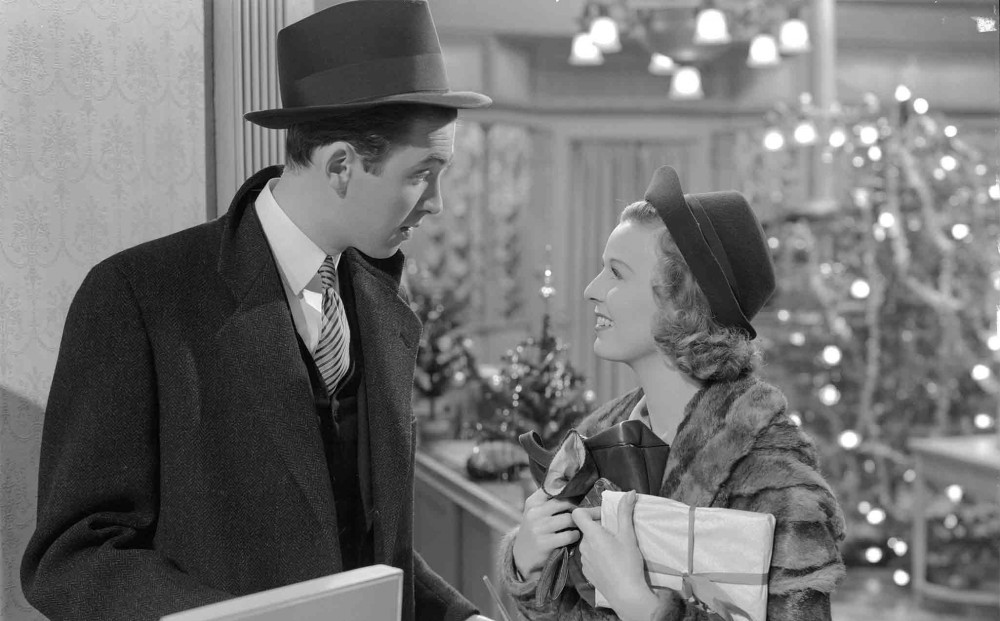From the laugh-a-minute Christmas in Connecticut to family heart-warmer Meet Me in St. Louis, Christmas in 1940s cinema was varied, lucrative and popular. Steph Green talks through some of the silver screen classics to seek out.
The 1940s was a tumultuous decade for obvious reasons. After the Allied victory of World War II, it wasn’t long before the United States were soon heading towards the Cold War, resulting in mass domestic paranoia. Unsurprisingly, Hollywood reflected these various upheavals. Most will remember this period of time for the film noir, with filmmakers and screenwriters venting their political frustrations on the silver screen. Crooked villains lurked in the shadows; hardboiled investigators rooted out spies, temptresses seduced. But why were there, conversely, so many Christmas movies?
Christmas in 1940s cinema wasn’t as formulaic as our contemporary equivalents, which sees every filmmaker doggedly trying to replicate the success of Love Actually. These wartime and post-war films both embraced and mocked the idea of the nuclear family as a force for good, with wildly different films verging from the saccharine to the satirical. Many were laden with puritanical morals, depicting an obstacle that had to be overcome in order to forge a path towards having the ‘traditional’ American family. Others were comedies that made a farce out of the girl-next-door homemaker. Some 1940s Christmas films were even film noirs themselves, ambitiously connecting two disparate genres into one moody, yuletide feature. With a widening political gulf in the country’s consciousness at the time, it’s no surprise that they all disagreed how powerful Christmas really is in uniting us all.

In Vincente Minnelli’s 1942 film Meet Me in St. Louis, much is made of the family space as a utopia. The idyllic rural lifestyle is generously filmed with decadent production design and technicolour pizzazz. Esther (Judy Garland) is dead set against moving from her beloved St. Louis, Missouri, where she lives in blissful, genteel luxury. Everything she needs is here: her perfect siblings, her maids, her huge house. She gazes out of her window onto her large lawn, singing “How can I ignore the boy next door / I love him more than I can say.” Her father is the one trying to uproot the family; he’s the classic image of the overworked corporate father, who has lost touch with what ‘matters’ most in life. Unsurprisingly, the film’s emotional climax arrives when he decides not to leave his family home after all. Staying in Missouri means eschewing all the modernity and new ideas of the big city and being loyal to a family-based traditionalism. The message is clear: stick to your home comforts and don’t try anything radical or new.
Similarly, Henry Koster’s The Bishop’s Wife gets its emotional kicks from traditional values: religion and family. David Niven plays Henry, a bishop who is obsessed with building a grand new cathedral and trying to persuade the rich widows in his town to finance it. The cost, though, is that he is neglecting his wife, Julia, and daughter, Debby, in the process. The film is still pretty surreal despite its safe concept: an angel, Dudley (Cary Grant), suddenly turns up, determined to spiritually guide the family through their crisis. Sparks fly between the suave Dudley and Julia, their love growing during flirty ice-skating sessions and Christmas shopping trips. Although it may have been more radical for Julia to end up with the dashing angel, ultimately she reaffirms her love for her pious husband, with the film’s rousing finale ending on a religious sermon reaffirming the importance of family. Cary Grant proves that angels don’t have to be clad in white feathers: it’s that guy in the suit, a cleft in his chin, helping the blind cross the road. It’s saccharine, but utterly effective: the snowy landscapes and heart-warming family feeling works on tugging the heartstrings.

But not every Christmas film in the 1940s had pious homemakers as their central female characters, desperately clinging onto nostalgia and family values. Enter Barbara Stanwyck. In 1945’s Christmas in Connecticut she plays journalist Elizabeth Lane, who, back then, may have been described as a ‘modern woman.’ Strapped for cash and a terrible chef, she pretends to be the perfect home-maker and housewife in her newspaper column, which is read by thousands. She’s able to blissfully keep up this lie until a Jefferson, a soldier wounded in a Nazi ambush on a submarine, reads her column while recuperating. When Elizabeth is forced by her editor to invite the soldier into her home as her “patriotic duty,” a comedy of errors ensues.
What makes Christmas in Connecticut quietly radical is how it proves that, actually, the image of the perfect housewife is quite literally a farce. From the Connecticut farm she borrows from a lovestruck acquaintance to the baby she looks after and pretends is hers, domesticity—as idolised in the 1940s—is painted as ridiculous. Elizabeth, a working woman who would rather buy a mink fur coat than learn to roast the perfect turkey, is satirically pitted as being at odds with maternal instinct. But not only does the film perfectly upend the idea of the perfect American woman in 1940s, it also mocks contemporary ideals: at a dance, a sign humorously reads: “WISHING YOU A MERRY CHRISTMAS, BUY WAR BONDS.” This tongue-in-cheek look at war couldn’t be more different to 1940’s The Shop Around the Corner, starring a young, wiry James Stewart and Margaret Sullavan. A Christmas classic, it depicts two employees working in a gift shop in December who hate each other in real life, but are inadvertently falling in love as pen-pals. Despite its setting of Budapest, the film ignores regional politics and Hungary’s role in a war that was very much still raging.
What happens when you try and combine a Christmas movie with a film noir? Well, the Letterboxd description of Christmas Holiday (1944) gives you a clue: “Don’t be fooled by the title. Christmas Holiday is a far, far cry from It’s a Wonderful Life.” This moody noir stars Deanna Durbin as Abigail, a wide-eyed, lovestruck young woman who marries Robert (Gene Kelly), not knowing about his violent streak. Contrasting scenes pit the wholesomeness of the festive season with her desperate situation. Plunging necklines and husky singing in smoky bars are placed aside Christmas midnight mass in a series of jarring flashbacks. In scenes before she is aware of her husband’s deadly crime, she knits and sings by candlelight, the perfect nuclear family: but it’s all a lie. Decidedly an anti-romance, Christmas Holiday flushes the idea of Christmas as an infallible family-friendly occasion down the toilet. It quite literally couldn’t be more different to Meet Me in St. Louis. Its sardonic tone isn’t surprising: the script was penned by Herman J. Mankiewicz, whose whiskey-soaked wit was so legendary that David Fincher directed a biopic about him (Mank, released December 2020).
Since the start of the COVID-19 pandemic, people have cynically been noting that most Christmas adverts this year and last year are all be about ‘how what really matters if family.’ It’s clear that, in the 1940s, the Christmas movie both embraced and mocked this idea of family as a foolproof way to get through hardship. So is it fair to say that our current crisis will trigger a decade of feel-good cinema? In my opinion, the jury’s still out.
Christmas in 1940s cinema watchlist:
The Shop Around The Corner (1940), Remember the Night (1940), Christmas in July (1940), Holiday Inn (1942), Meet Me in St. Louis (1942), Christmas Holiday (1944), Christmas in Connecticut (1945), It’s a Wonderful Life (1946), The Bishop’s Wife (1947), It Happened on Fifth Avenue (1947), Miracle on 34th Street (1947), Holiday Affair (1949)
Words by Steph Green
Support The Indiependent
We’re trying to raise £200 a month to help cover our operational costs. This includes our ‘Writer of the Month’ awards, where we recognise the amazing work produced by our contributor team. If you’ve enjoyed reading our site, we’d really appreciate it if you could donate to The Indiependent. Whether you can give £1 or £10, you’d be making a huge difference to our small team.


